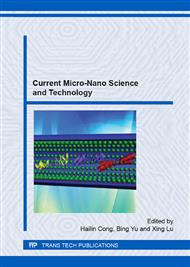p.37
p.43
p.47
p.55
p.62
p.67
p.72
p.77
p.83
The Standard Formation Enthalpies of Spherical ZnO Nano-Particles: Size Matters
Abstract:
Four kinds of spherical nanoZnO particles with diameter of 20 nm, 30 nm, 40 nm and 50 nm were characterized by XRD and SEM. Based on a thermodynamic cycle, the standard molar formation enthalpies (ΔfHm) were measured and calculated by the RD496-2000 micro-calorimeter. They are (-328.41±1.575) kJ·mol–1 (50 nm), (-323.11 ± 1.579) kJ·mol–1 (40 nm), (-313.47 ± 1.581) kJ·mol–1 (30 nm), (-307.66 ±1.616) kJ·mol–1 (20 nm). The results show that nanosized ZnO has higher standard molar formation enthalpy compared to that of bulk ZnO (–350.46 ± 0.27 kJ·mol–1), indicating that the stability of nanosized ZnO decreases. More interestingly, the results show that the smaller size of the ZnO nanoparticles, the higher standard molar formation enthalpy was obtained. This indicates that ZnO nanoparticles get destabilized when the size decreases. The value of the standard molar formation enthalpies y (kJ·mol–1) and size x (nm) can be approximately described by a linear function of y = –0.7189 x –293.
Info:
Periodical:
Pages:
62-66
Citation:
Online since:
July 2015
Authors:
Price:
Сopyright:
© 2015 Trans Tech Publications Ltd. All Rights Reserved
Share:
Citation:


